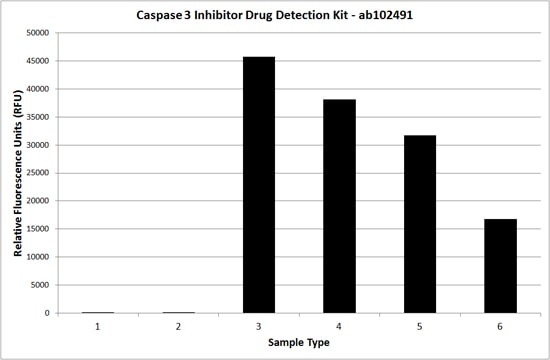Caspase-3 Inhibitor Assay Kit (ab102491)
Key features and details
- Assay type: Quantitative
- Detection method: Fluorescent
- Platform: Microplate reader
- Assay time: 1 hr 30 min
- Sample type: Adherent cells, Suspension cells
Overview
-
Product name
Caspase-3 Inhibitor Assay Kit
See all Caspase-3 kits -
Detection method
Fluorescent -
Sample type
Adherent cells, Suspension cells -
Assay type
Quantitative -
Assay time
1h 30m -
Product overview
Abcam's Caspase-3 Inhibitor Drug Detection Kit provides an effective means for screening caspase inhibitors using fluorometric methods. The assay utilizes synthetic peptide substrate DEVD-AFC (AFC, 7-amino-4-trifluoromethyl coumarin). Active Caspase-3 cleaves the synthetic substrate to release free AFC which can then be quantified by fluorometry. Compounds to be screened can directly be added to the reaction and the level of inhibition of Caspase-3 activity can be determined by comparison of the fluorescence intensity in samples with and without the testing inhibitors.
Visit our FAQs page for tips and troubleshooting. -
Notes
Caspases have been shown to play a crucial role in apoptosis induced by various deleterious and physiologic stimuli. Inhibition of caspases can delay apoptosis, implicating a potential role in drug screening efforts.
-
Platform
Microplate reader
Properties
-
Storage instructions
Store at -20°C. Please refer to protocols. -
Components 100 tests 2X Reaction Buffer 1 x 10ml Active Caspase-3 1 x 100 units Caspase Substrate DEVD-AFC 1 x 0.5ml Caspase-3 Inhibitor 1 x 10µl DTT 1 x 100µl -
Research areas
-
Relevance
The caspase family of cysteine proteases play a key role in apoptosis. Caspase 3 (also known as CPP32, YAMA and apopain) is the most extensively studied apoptotic protein among caspase family members. Caspase 3 is synthesized as an inactive pro enzyme that is processed in cells undergoing apoptosis by self proteolysis and/or cleavage by other upstream proteases (e.g. Caspases 8, 9 and 10). The processed form of Caspase 3 consists of large (17kD) and small (12kD) subunits which associate to form an active enzyme. Caspase 3 is cleaved at Asp28 - Ser29 and Asp175 - Ser176. The active Caspase 3 proteolytically cleaves and activates other caspases (e.g. Caspases 6, 7 and 9), as well as relevant targets in the cells (e.g. PARP and DFF). Alternative splicing of this gene results in two transcript variants which encode the same protein. In immunohistochemical studies Caspase 3 expression has been shown to be widespread but not present in all cell types (e.g. commonly reported in epithelial cells of skin, renal proximal tubules and collecting ducts). Differences in the level of Caspase 3 have been reported in cells of short lived nature (eg germinal centre B cells) and those that are long lived (e.g. mantle zone B cells). Caspase 3 is the predominant caspase involved in the cleavage of amyloid beta 4A precursor protein, which is associated with neuronal death in Alzheimer's disease. -
Cellular localization
Cytoplasmic -
Alternative names
- A830040C14Rik
- Apopain
- Apopain precursor
see all
Images
-
Titration of the Caspase inhibitor Z-VAD(OMe)-FMK (ab120487) (duplicates; +/- SD).
-
Titration of the Caspase-3 specific inhibitor Q-DEVD-OPh (ab142037) (duplicates; +/- SD).
-
Caspase activity (RFU) in presence of 0µM - 40µM of z-VAD-FMK (generic caspase inhibitor), assessed using DEVD-AFC as caspase-3 substrate and following Caspase-3 Inhibitor Drug Detection Kit (ab102491) protocol. Lanes:
1.- Background Control: no Caspase-3, no z-VMAD-FMK
2.- Positive Inhibition Control: no Caspase-3, +z-VAD-FMK
3.- Positive Control: + Caspase-3, no z-VAD-FMK
4.- Caspase-3 + 2.5µM z-VAD-FMK
5.- Caspase-3 + 10µM z-VAD-FMK
6.- Caspase-3 + 40µM z-VAD-FMK















